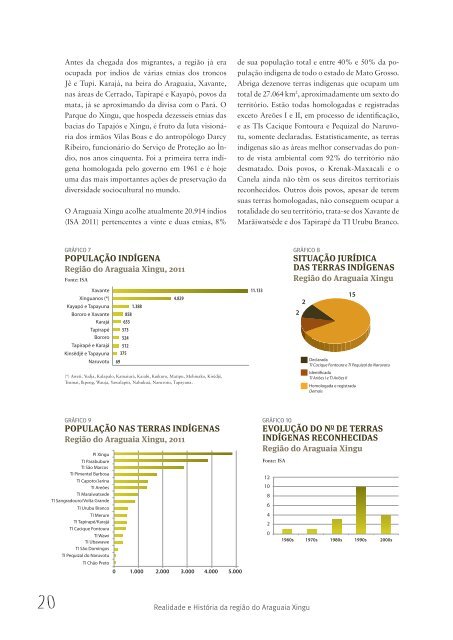You also want an ePaper? Increase the reach of your titles
YUMPU automatically turns print PDFs into web optimized ePapers that Google loves.
Antes <strong>da</strong> chega<strong>da</strong> dos migrantes, a região já era<br />
ocupa<strong>da</strong> por índios de várias etnias dos troncos<br />
Jê e Tupi. Karajá, na beira do Araguaia, Xavante,<br />
nas áreas de Cerrado, Tapirapé e Kayapó, povos <strong>da</strong><br />
mata, já se aproximando <strong>da</strong> divisa com o Pará. O<br />
Parque do <strong>Xingu</strong>, que hospe<strong>da</strong> dezesseis etnias <strong>da</strong>s<br />
bacias do Tapajós e <strong>Xingu</strong>, é fruto <strong>da</strong> luta visionária<br />
dos irmãos Vilas Boas e do antropólogo Darcy<br />
Ribeiro, funcionário do Serviço de Proteção ao Índio,<br />
nos anos cinquenta. Foi a primeira <strong>terra</strong> indígena<br />
homologa<strong>da</strong> pelo governo em 1961 e é hoje<br />
uma <strong>da</strong>s mais importantes ações de preservação <strong>da</strong><br />
diversi<strong>da</strong>de sociocultural no mundo.<br />
O Araguaia <strong>Xingu</strong> acolhe atualmente 20.914 índios<br />
(ISA 2011) pertencentes a vinte e duas etnias, 8%<br />
GRÁFICO 7<br />
POPULAÇÃO INDÍGENA<br />
Região do Araguaia <strong>Xingu</strong>, 2011<br />
Fonte: ISA<br />
Xavante 11.133<br />
<strong>Xingu</strong>anos (*)<br />
4.829<br />
Kayapó e Tapayuna 1.388<br />
Bororo e Xavante 858<br />
Karajá 653<br />
Tapirapé 573<br />
Bororo 524<br />
Tapirapé e Karajá 512<br />
Kinsêdjê e Tapayuna 375<br />
Naruvotu 69<br />
(*) Aweti, Yudja, Kalapalo, Kamaiurá, Kaiabi, Kuikuro, Matipu, Mehinako, Kisêdjê,<br />
Trumai, Ikpeng, Wauja, Yawalapiti, Nahukuá, Naruvotu, Tapayuna.<br />
GRÁFICO 9<br />
POPULAÇÃO NAS TERRAS INDÍGENAS<br />
Região do Araguaia <strong>Xingu</strong>, 2011<br />
PI <strong>Xingu</strong><br />
TI Parabubure<br />
TI São Marcos<br />
TI Pimentel Barbosa<br />
TI Capoto/Jarina<br />
TI Areões<br />
TI Maraiwatsede<br />
TI Sangradouro/Volta Grande<br />
TI Urubu Branco<br />
TI Merure<br />
TI Tapirapé/Karajá<br />
TI Cacique Fontoura<br />
TI Wawi<br />
TI Ubawawe<br />
TI São Domingos<br />
TI Pequizal do Naruvotu<br />
TI Chão Preto<br />
0 1.000 2.000 3.000 4.000 5.000<br />
20 Reali<strong>da</strong>de e História <strong>da</strong> região do Araguaia <strong>Xingu</strong><br />
de sua população total e entre 40% e 50% <strong>da</strong> população<br />
indígena de todo o estado de Mato Grosso.<br />
Abriga dezenove <strong>terra</strong>s indígenas que ocupam um<br />
total de 27.064 km 2 , aproxima<strong>da</strong>mente um sexto do<br />
território. Estão to<strong>da</strong>s homologa<strong>da</strong>s e registra<strong>da</strong>s<br />
exceto Areões I e II, em processo de identificação,<br />
e as TIs Cacique Fontoura e Pequizal do Naruvotu,<br />
somente declara<strong>da</strong>s. Estatisticamente, as <strong>terra</strong>s<br />
indígenas são as áreas melhor conserva<strong>da</strong>s do ponto<br />
de vista ambiental com 92% do território não<br />
desmatado. Dois povos, o Krenak-Maxacali e o<br />
Canela ain<strong>da</strong> não têm os seus direitos territoriais<br />
reconhecidos. Outros dois povos, apesar de terem<br />
suas <strong>terra</strong>s homologa<strong>da</strong>s, não conseguem ocupar a<br />
totali<strong>da</strong>de do seu território, trata-se dos Xavante de<br />
Marãiwatséde e dos Tapirapé <strong>da</strong> TI Urubu Branco.<br />
GRÁFICO 8<br />
SITUAÇÃO JURÍDICA<br />
DAS TERRAS INDÍGENAS<br />
Região do Araguaia <strong>Xingu</strong><br />
GRÁFICO 10<br />
EVOLUÇÃO DO N O DE TERRAS<br />
INDÍGENAS RECONHECIDAS<br />
Região do Araguaia <strong>Xingu</strong><br />
Fonte: ISA<br />
12<br />
10<br />
8<br />
6<br />
4<br />
2<br />
0<br />
2<br />
2<br />
15<br />
Declara<strong>da</strong><br />
TI Cacique Fontoura e TI Pequizal do Naruvotu<br />
Identica<strong>da</strong><br />
TI Ariões I e TI Ariões II<br />
Homologa<strong>da</strong> e registra<strong>da</strong><br />
Demais<br />
1960s 1970s 1980s 1990s 2000s


